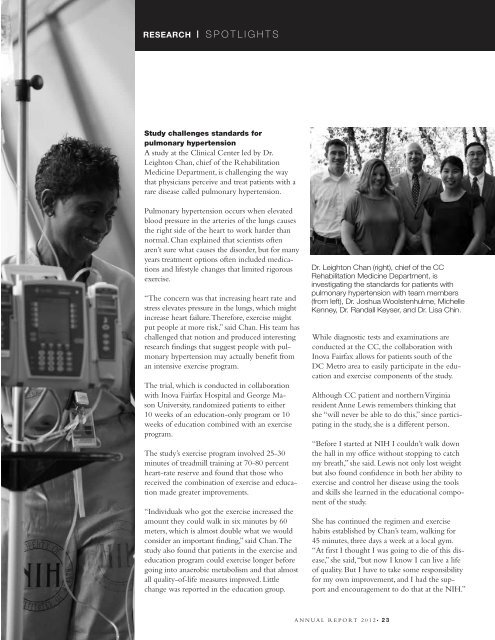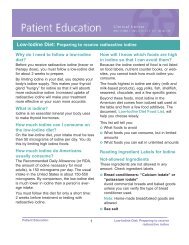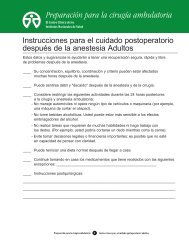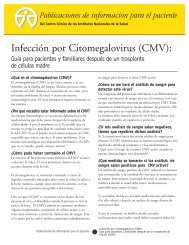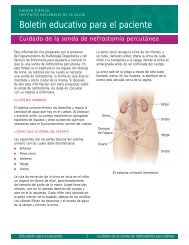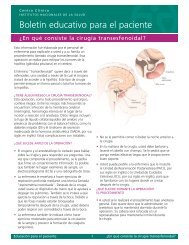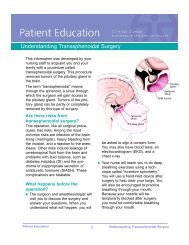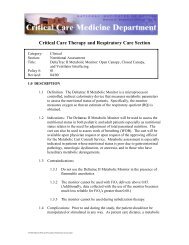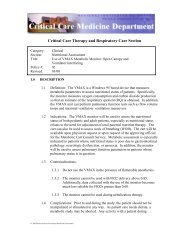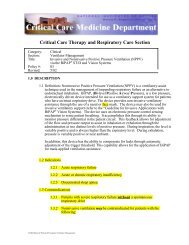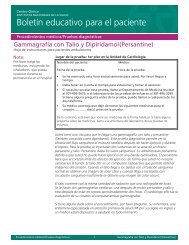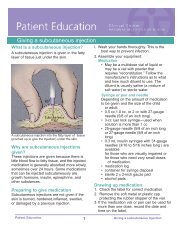NIH Clinical Center Profile 2012 - Search - National Institutes of Health
NIH Clinical Center Profile 2012 - Search - National Institutes of Health
NIH Clinical Center Profile 2012 - Search - National Institutes of Health
You also want an ePaper? Increase the reach of your titles
YUMPU automatically turns print PDFs into web optimized ePapers that Google loves.
RESEARCH | S P O T L I G H T S<br />
Study challenges standards for<br />
pulmonary hypertension<br />
A study at the <strong>Clinical</strong> <strong>Center</strong> led by Dr.<br />
Leighton Chan, chief <strong>of</strong> the Rehabilitation<br />
Medicine Department, is challenging the way<br />
that physicians perceive and treat patients with a<br />
rare disease called pulmonary hypertension.<br />
Pulmonary hypertension occurs when elevated<br />
blood pressure in the arteries <strong>of</strong> the lungs causes<br />
the right side <strong>of</strong> the heart to work harder than<br />
normal. Chan explained that scientists <strong>of</strong>ten<br />
aren’t sure what causes the disorder, but for many<br />
years treatment options <strong>of</strong>ten included medications<br />
and lifestyle changes that limited rigorous<br />
exercise.<br />
“The concern was that increasing heart rate and<br />
stress elevates pressure in the lungs, which might<br />
increase heart failure. Therefore, exercise might<br />
put people at more risk,” said Chan. His team has<br />
challenged that notion and produced interesting<br />
research findings that suggest people with pulmonary<br />
hypertension may actually benefit from<br />
an intensive exercise program.<br />
The trial, which is conducted in collaboration<br />
with Inova Fairfax Hospital and George Mason<br />
University, randomized patients to either<br />
10 weeks <strong>of</strong> an education-only program or 10<br />
weeks <strong>of</strong> education combined with an exercise<br />
program.<br />
The study’s exercise program involved 25-30<br />
minutes <strong>of</strong> treadmill training at 70-80 percent<br />
heart-rate reserve and found that those who<br />
received the combination <strong>of</strong> exercise and education<br />
made greater improvements.<br />
“Individuals who got the exercise increased the<br />
amount they could walk in six minutes by 60<br />
meters, which is almost double what we would<br />
consider an important finding,” said Chan. The<br />
study also found that patients in the exercise and<br />
education program could exercise longer before<br />
going into anaerobic metabolism and that almost<br />
all quality-<strong>of</strong>-life measures improved. Little<br />
change was reported in the education group.<br />
Dr. Leighton Chan (right), chief <strong>of</strong> the CC<br />
Rehabilitation Medicine Department, is<br />
investigating the standards for patients with<br />
pulmonary hypertension with team members<br />
(from left), Dr. Joshua Woolstenhulme, Michelle<br />
Kenney, Dr. Randall Keyser, and Dr. Lisa Chin.<br />
While diagnostic tests and examinations are<br />
conducted at the CC, the collaboration with<br />
Inova Fairfax allows for patients south <strong>of</strong> the<br />
DC Metro area to easily participate in the education<br />
and exercise components <strong>of</strong> the study.<br />
Although CC patient and northern Virginia<br />
resident Anne Lewis remembers thinking that<br />
she “will never be able to do this,” since participating<br />
in the study, she is a different person.<br />
“Before I started at <strong>NIH</strong> I couldn’t walk down<br />
the hall in my <strong>of</strong>fice without stopping to catch<br />
my breath,” she said. Lewis not only lost weight<br />
but also found confidence in both her ability to<br />
exercise and control her disease using the tools<br />
and skills she learned in the educational component<br />
<strong>of</strong> the study.<br />
She has continued the regimen and exercise<br />
habits established by Chan’s team, walking for<br />
45 minutes, three days a week at a local gym.<br />
“At first I thought I was going to die <strong>of</strong> this disease,”<br />
she said, “but now I know I can live a life<br />
<strong>of</strong> quality. But I have to take some responsibility<br />
for my own improvement, and I had the support<br />
and encouragement to do that at the <strong>NIH</strong>.”<br />
A N N U A L R E P O RT 2 0 1 2 • 2 3


